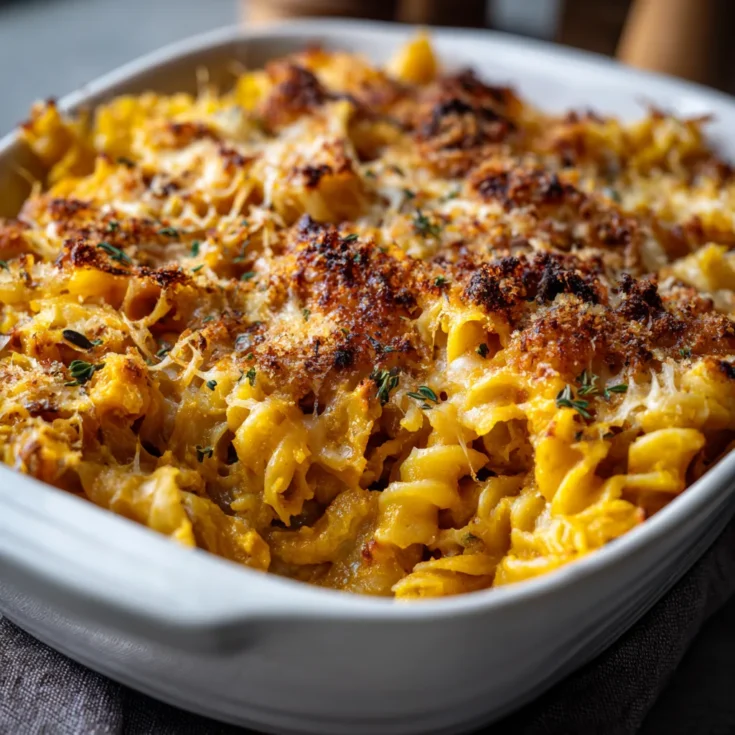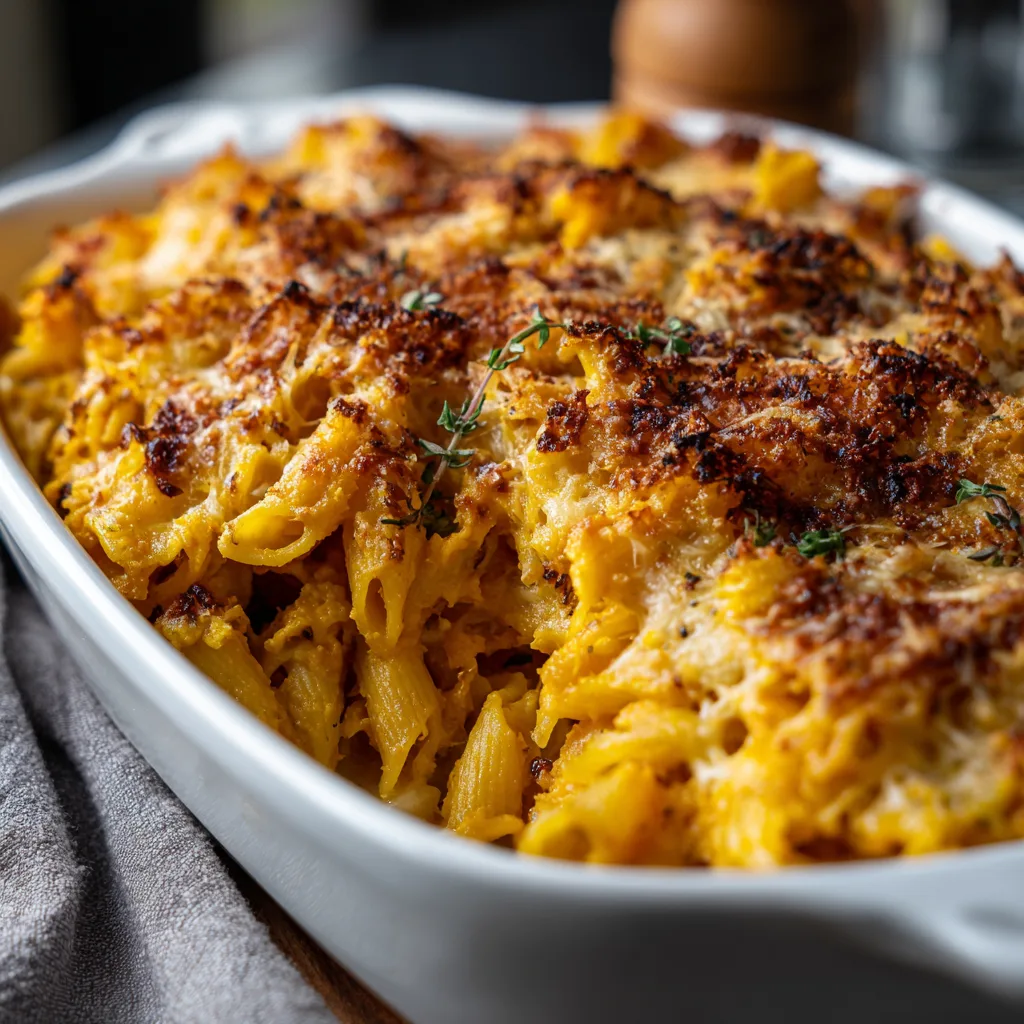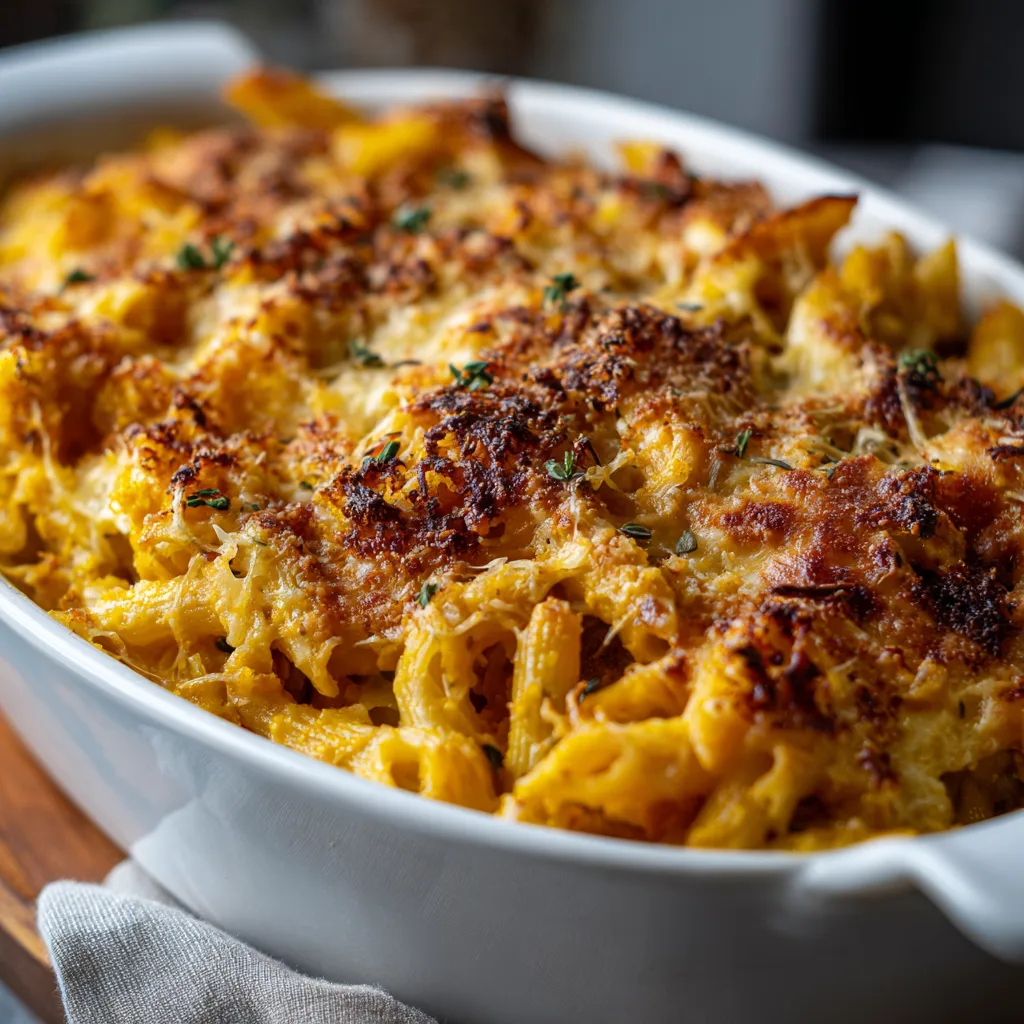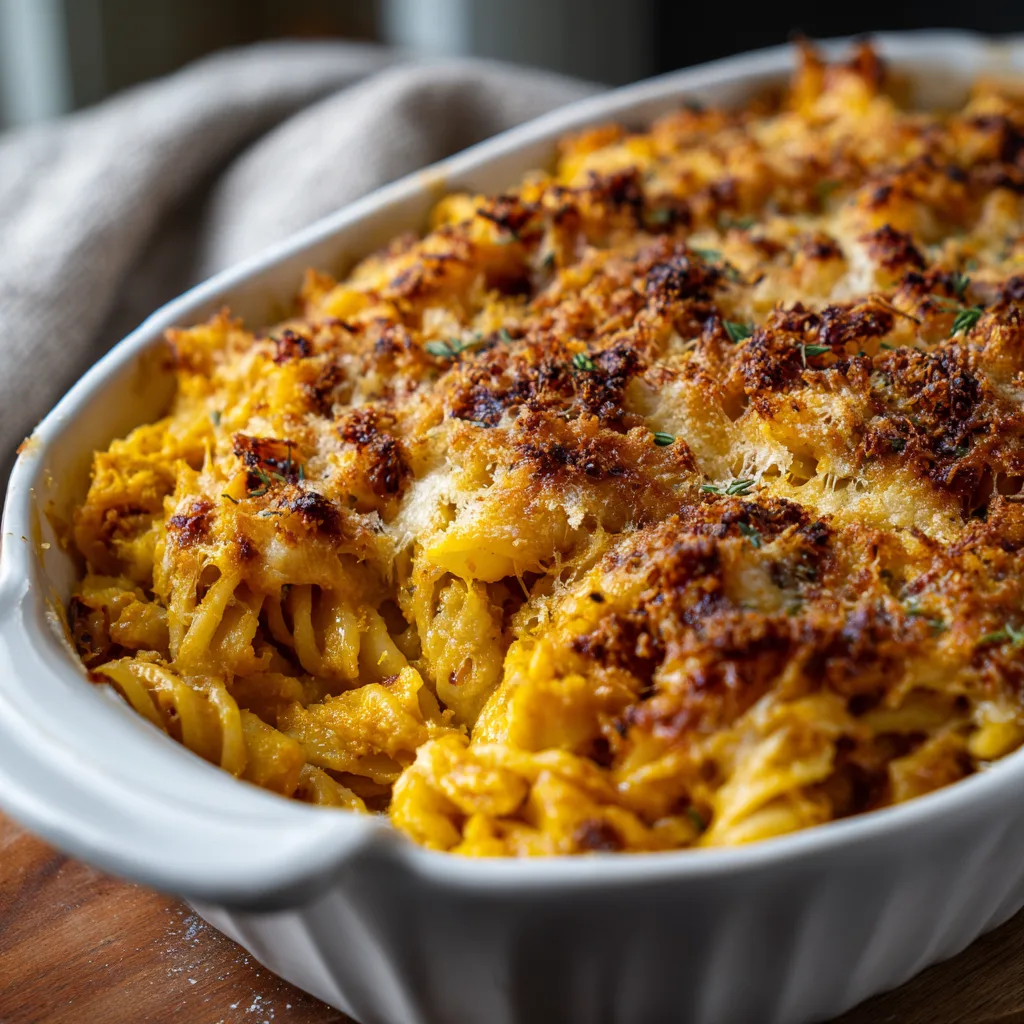Baked Easy Pumpkin Pasta – A Cozy, Flavorful Fall Favorite
When the crisp air of fall arrives, our cravings shift toward warm, comforting dishes. Baked easy pumpkin pasta perfectly fits this seasonal desire. This dish combines creamy pumpkin sauce with tender pasta, baked to golden perfection. It offers a cozy meal that warms both body and soul during chilly fall and winter days.
Pumpkin pasta gains popularity in cooler months because it uses seasonal produce and delivers rich, comforting flavors. The natural sweetness of pumpkin blends beautifully with savory ingredients, creating a unique balance that feels indulgent yet wholesome. This makes it an ideal choice for anyone seeking a hearty meal without heaviness.
What makes baked pumpkin pasta especially appealing is its simplicity. The recipe uses easy-to-find ingredients and requires minimal prep, making it accessible for home cooks of all skill levels. Its creamy texture and subtle spices elevate pasta into something special. Whether you prefer a mild flavor or a hint of warmth from spices like nutmeg and sage, this dish adapts well.
Additionally, baked pumpkin pasta offers impressive versatility. Vegetarians can enjoy it fully by focusing on pumpkin and cheese combinations. For those wanting a twist, different pasta shapes like penne, rigatoni, or fusilli work wonderfully. You can also customize toppings or add vegetables and proteins to suit your taste and dietary needs.
This article will guide you step-by-step through creating the perfect baked easy pumpkin pasta. You will learn about essential ingredients, preparation techniques, variations, and tips to master this flavorful fall favorite. Whether you are a seasoned cook or a beginner, you’ll find all the information needed to make this dish a regular part of your seasonal menu.
Essential Ingredients for Baked Pumpkin Pasta
Choosing the right ingredients shapes the success of baked pumpkin pasta. First, deciding between fresh and canned pumpkin matters. Fresh pumpkin offers a vibrant, natural flavor but requires peeling and cooking, which can take extra time. Canned pumpkin puree, on the other hand, provides convenience and consistent texture. For most recipes, high-quality canned pumpkin works perfectly and saves effort without sacrificing taste.
Next, selecting the pasta is important. Pasta shapes like penne, rigatoni, and fusilli hold sauce well and bake evenly. These varieties allow creamy pumpkin sauce to cling to each bite. Avoid delicate noodles like spaghetti, which may become mushy after baking.
Cheese plays a vital role in richness. Mozzarella melts smoothly, creating a gooey texture. Parmesan adds a sharp, savory depth, while ricotta offers creaminess and subtle sweetness. You can mix and match cheeses based on preference or availability. For lighter options, consider part-skim cheeses or dairy-free alternatives.
Creaminess comes from heavy cream or substitutes like coconut milk. Heavy cream creates a luscious sauce with a silky mouthfeel. Coconut milk is an excellent dairy-free alternative that adds a hint of natural sweetness and pairs well with pumpkin’s earthiness.
Flavor enhancers bring the dish to life. Garlic and onions provide foundational savory notes. Fresh or dried herbs such as sage, thyme, and rosemary complement pumpkin’s sweetness perfectly. These herbs add warmth and complexity.
Pumpkin shines when paired with spices like nutmeg, cinnamon, and black pepper. Nutmeg introduces subtle warmth, cinnamon lends a gentle sweetness, and black pepper adds mild heat. Together, they create a balanced spice profile without overpowering the dish.
Optional add-ins let you personalize the recipe. Spinach or mushrooms add color and texture, while nuts like toasted walnuts or pecans contribute crunch. For those who enjoy meat, sausage can add bold, savory flavors that enhance the overall dish.
Ingredient Substitutions and Dietary Considerations
For gluten-free diets, many pasta brands offer corn, rice, or chickpea-based options that bake well without losing texture. Always cook gluten-free pasta al dente to prevent mushiness.
Vegan versions are simple with dairy-free cheeses and coconut milk or plant-based cream alternatives. Nutritional yeast can replace parmesan to deliver a cheesy flavor without animal products.
Using fresh pumpkin puree provides the freshest flavor but requires roasting or boiling pumpkin chunks until soft and then pureeing. Canned pumpkin puree offers speed and consistency but check labels to avoid added sugars or spices.
For lighter meals, substitute heavy cream with half-and-half or milk, though the sauce will be less rich. You can reduce cheese quantities or choose low-fat options. Using olive oil instead of butter cuts saturated fat while maintaining flavor.
By understanding these ingredient choices and substitutions, you can customize baked pumpkin pasta to your dietary needs and preferences without sacrificing taste or texture.
Preparing the Pumpkin Sauce
Start by preparing your pumpkin puree. If using fresh pumpkin, peel and cut it into chunks. Roast the pieces in the oven at 400°F (200°C) for about 30-40 minutes until tender. Then, blend the roasted pumpkin until smooth. For convenience, canned pumpkin puree works just as well—choose plain pumpkin without added sugars or spices.
Next, build a flavorful base by sautéing aromatics. Heat olive oil or butter in a skillet over medium heat. Add finely chopped onions and cook until translucent, about 3-5 minutes. Toss in minced garlic and sauté for another minute, releasing its rich aroma. This layer creates depth in your sauce.
Now, stir in your pumpkin puree with the aromatics. Slowly pour in heavy cream or your chosen creamy substitute while stirring gently. Add spices like nutmeg, cinnamon, salt, and black pepper. Let the sauce simmer on low heat for 5 to 7 minutes. Stir often to avoid lumps and allow flavors to meld. If the sauce feels too thick, thin it with a splash of broth or milk.
To achieve a smooth, creamy texture, whisk continuously during simmering. Avoid boiling vigorously, as this can cause the cream to separate. If lumps form, a quick blend with an immersion blender smooths the sauce effortlessly.
Cooking the Pasta Perfectly
Cooking pasta al dente ensures it holds its shape after baking. Bring a large pot of salted water to a rolling boil. Add pasta and cook according to package instructions, reducing the time by one or two minutes to keep the pasta slightly firm.
Drain the pasta promptly to prevent overcooking. Rinsing is not necessary unless you plan to stop the cooking immediately; simply toss with a bit of olive oil to avoid sticking.
Avoid cooking pasta fully since it will continue cooking in the oven. Overcooked pasta becomes mushy after baking, ruining the dish’s texture.
Assembling the Baked Pumpkin Pasta
In a large mixing bowl, combine the drained pasta with the prepared pumpkin sauce. Mix until every piece is coated evenly. Stir in half of the shredded mozzarella and grated parmesan to infuse richness throughout.
Transfer the mixture to a greased baking dish. Spread it evenly for consistent baking. Sprinkle the remaining cheese over the top for a golden crust. For added crunch, scatter breadcrumbs or crushed nuts on top.
Layering ingredients carefully enhances texture. The sauce coats the pasta, while cheese melts and browns on the surface, creating a satisfying contrast between creamy and crispy.
Baking Tips and Tricks
Preheat your oven to 375°F (190°C). Bake the assembled pasta for 20 to 25 minutes. The top should bubble and turn golden brown, signaling it’s perfectly cooked.
Check doneness by inserting a fork into the center. The pasta should feel tender but not mushy. If the top browns too quickly, cover loosely with foil to prevent burning while the inside finishes cooking.
To avoid dryness, don’t skimp on sauce or cheese; they keep the dish moist. If the sauce thickens during baking, add a splash of cream or broth before serving.
Let the pasta rest for about 10 minutes after baking. This step allows the sauce to thicken slightly and flavors to settle, making every bite satisfying.
Following these steps guarantees a creamy, flavorful baked pumpkin pasta that’s comforting and visually appealing.
Creative Variations on Baked Pumpkin Pasta
Baked pumpkin pasta adapts easily to different tastes and dietary needs. Adding proteins like shredded chicken, Italian sausage, or tofu boosts heartiness and adds extra flavor. For a vegetarian boost, try sautéed mushrooms or roasted chickpeas.
Incorporate vegetables such as spinach, kale, or roasted bell peppers to increase nutrition and add color. These veggies blend well with pumpkin’s natural sweetness while providing texture contrasts.
Adjust the spice level to suit your palate. Keep it mild with just a pinch of nutmeg and black pepper, or add red pepper flakes or cayenne for a gentle kick. Experimenting with spices lets you create a version tailored to your preferences.
Swap cheeses to diversify flavor. Use creamy goat cheese for tang, smoked mozzarella for depth, or sharp cheddar for richness. Mixing different cheeses can create complex taste layers that elevate the dish.
Serving Suggestions and Pairings
Serve baked pumpkin pasta alongside fresh salads with crisp greens and tangy vinaigrettes to balance the creaminess. Roasted vegetables like Brussels sprouts, carrots, or asparagus add earthiness and complement the pasta’s flavors.
For a casual meal or dinner party, present the pasta in a rustic baking dish or individual ramekins for a charming touch. Garnish with fresh herbs like parsley or sage leaves to brighten the presentation.
Pair the dish with non-alcoholic beverages such as sparkling water with a splash of citrus or lightly spiced herbal teas. These options refresh the palate without overwhelming the subtle pumpkin flavors.
Storing and Reheating Leftovers
Store leftover baked pumpkin pasta in an airtight container in the refrigerator. Consume within 3 to 4 days for optimal freshness and safety.
Reheat gently in the oven at 350°F (175°C) until warmed through. Cover the dish with foil to retain moisture and prevent the top from drying out. Alternatively, reheat individual portions in the microwave, stirring occasionally to ensure even heat.
For longer storage, freeze the pasta in freezer-safe containers. Thaw overnight in the refrigerator before reheating. This method preserves flavor and texture well, allowing you to enjoy the dish days or weeks later.
Proper storage and reheating maintain the pasta’s creamy texture and delicious taste, making it a convenient and satisfying meal anytime.
Common Questions About Baked Easy Pumpkin Pasta
What type of pumpkin is best for pumpkin pasta?
Sugar pumpkins or pie pumpkins are ideal for cooking. They have a sweeter, denser flesh compared to large carving pumpkins, making them perfect for a smooth, flavorful sauce. However, canned pumpkin puree offers a convenient and consistent alternative.
Can I make baked pumpkin pasta vegan or gluten-free?
Yes! Use gluten-free pasta made from rice, corn, or legumes. For a vegan version, swap dairy cream and cheese with coconut milk or plant-based cream and vegan cheese. Nutritional yeast adds a cheesy flavor without dairy.
How long does baked pumpkin pasta keep in the fridge?
Store leftovers in an airtight container. They stay fresh for 3 to 4 days. Reheat thoroughly before eating to maintain taste and texture.
Can I prepare this dish ahead of time and freeze it?
Absolutely. Assemble the pasta but don’t bake it. Freeze in a suitable container for up to 2 months. When ready, thaw overnight in the fridge, then bake as usual.
What cheese works best in pumpkin pasta?
Mozzarella melts beautifully for gooey texture. Parmesan adds sharpness and depth. Ricotta offers creaminess and mild sweetness. Combining these cheeses creates a balanced flavor.
How can I make the pumpkin sauce thicker or thinner?
To thicken, simmer the sauce longer to reduce liquid or add a small amount of cream cheese or cornstarch slurry. To thin it, stir in extra cream, broth, or milk until you reach the desired consistency.
Is canned pumpkin the same as pumpkin pie filling?
No. Canned pumpkin is pure pumpkin puree with no added ingredients. Pumpkin pie filling contains sugars, spices, and other additives, so it’s not suitable for savory dishes like pumpkin pasta
Baked Easy Pumpkin Pasta Recipe – Creamy, Comforting & Seasonal

A creamy, comforting baked pasta dish featuring a rich pumpkin sauce, melted cheese, and aromatic herbs — perfect for fall and winter meals.
Ingredients
- 12 oz pasta (penne or rigatoni)
- 1 cup pumpkin puree (canned or fresh)
- 1 cup heavy cream or coconut milk
- 1 cup shredded mozzarella cheese
- 1/2 cup grated parmesan cheese
- 1 small onion, finely chopped
- 2 cloves garlic, minced
- 1 tsp fresh sage (or 1/2 tsp dried)
- 1/4 tsp nutmeg
- Salt and pepper to taste
- 2 tbsp olive oil
- Optional: breadcrumbs for topping
Instructions
Notes




